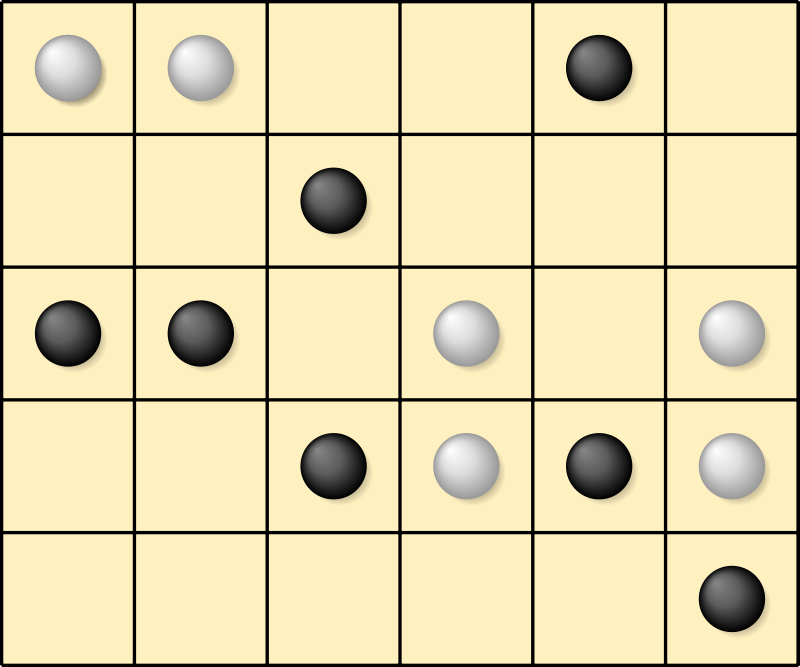Yoté is a traditional board game that is popular in West Africa. It is a two-player game that requires strategy and critical thinking. The game is played on a 6×5 board and each player starts with twelve pieces of their distinct color.

The game has a unique double-capture move that allows for a quick change of fortunes in the game. The goal is to capture all opposing pieces, and the game ends when one player has no pieces left on the board. Yoté is related to the game Choko, and both games have been played in West Africa for centuries.
Key Takeaways
- Yoté is a traditional board game that is popular in West Africa.
- The game is played on a 6×5 board and each player starts with twelve pieces of their distinct color.
- The game has a unique double-capture move that allows for a quick change of fortunes in the game.
History of Yoté
Origins and Evolution
Yoté is a traditional strategy board game that originated in West Africa. The game has been played for centuries and is believed to have evolved from an ancient Egyptian game called Senet. Yoté is also related to the game Choko, which is played in the Ivory Coast.
The game spread throughout West Africa, where it became a popular pastime among both adults and children. Yoté is often played in villages and towns, and is a common sight in markets and other public places. Over time, the game has evolved and adapted to different cultures and regions.
Cultural Significance
Yoté has significant cultural and social importance in West Africa. The game is often played during important events and celebrations, such as weddings, funerals, and religious festivals. It is also used as a means of settling disputes and conflicts.
In addition to its cultural significance, Yoté is also a popular gambling game. Players often bet on the outcome of the game, adding an extra element of excitement and competition.
Yoté has gained popularity outside of West Africa as well. The game has been introduced to other parts of the world, including Europe and North America. It has also been adapted to digital platforms, with online versions of the game now available.
Overall, Yoté is a game with a rich history and cultural significance. It has evolved and adapted over time, but its core gameplay and strategy remain the same. The game continues to be enjoyed by people of all ages and backgrounds, both in West Africa and beyond.
The Rules of Yoté
Game Setup
Yoté is a two-player abstract strategy game that is traditionally played on a board with a 5×6 grid of cells. Each player starts the game with 12 pieces, which are placed on the board in a specific configuration. The pieces are typically round and made of wood or stone, and they are either black or white.
Gameplay Mechanics
Players take turns moving their pieces on the board. A piece can be moved to any adjacent unoccupied cell along a horizontal or vertical line. If a player’s piece is adjacent to an opponent’s piece, the player can “capture” the opponent’s piece by jumping over it to the empty cell beyond. The captured piece is then removed from the board. If a player’s piece lands on a cell adjacent to two or more of the opponent’s pieces, the player can choose which piece to capture.
Players can make multiple jumps in a single turn, as long as each jump results in a capture. If a player’s piece reaches the last row on the opponent’s side of the board, it becomes a “king” and gains the ability to move diagonally as well as horizontally and vertically.
Winning Conditions
The game is won by either capturing all of the opponent’s pieces or trapping the opponent’s pieces so that they cannot make any more moves. If both players are reduced to only two pieces each, the game ends in a draw.
Yoté is a game that requires strategic thinking and careful planning. It is easy to learn but difficult to master, making it a popular game among players of all ages and skill levels.
Strategies in Yoté
Yoté is a traditional strategy board game of West Africa that requires a good balance of offensive and defensive tactics to win. In this section, we will discuss some of the common strategies used by Yoté players.
Offensive Tactics
In Yoté, the ultimate goal is to capture all of the opponent’s pieces. Therefore, offensive tactics are crucial to achieve this goal. One of the most common offensive tactics is to create a blockade by placing pieces in a way that restricts the opponent’s movement. This can be done by placing pieces in a diagonal line or in a square formation. By doing this, the opponent will have fewer options to move their pieces, making it easier to capture them.
Another effective offensive tactic is to lure the opponent’s pieces into a trap. This can be done by placing a piece in a position that forces the opponent to capture it, allowing the player to capture the opponent’s piece in return. This is known as a sacrifice move and can be a powerful way to gain an advantage.
Defensive Play
Defensive play is equally important in Yoté. A good defensive strategy is to create a strong defensive line by placing pieces in a way that protects the player’s pieces. This can be done by placing pieces in a diagonal line or in a square formation, similar to offensive tactics. By doing this, the opponent will have a harder time capturing the player’s pieces.
Another effective defensive tactic is to avoid making unnecessary moves. In Yoté, every move counts, and it is important not to waste moves on unnecessary actions. Instead, players should focus on positioning their pieces strategically and wait for the right moment to strike.
In conclusion, Yoté is a game that requires a good balance of offensive and defensive tactics. By creating a strong defensive line and using offensive tactics like creating a blockade or luring the opponent’s pieces into a trap, players can gain an advantage and ultimately capture all of their opponent’s pieces.
Variations of Yoté
Yoté is a slang term that is used to describe throwing something forcefully or discarding something quickly. While the term is widely used, there are some regional differences in how it is used and pronounced.
Regional Differences
In some regions, yoté is pronounced as “yote,” while in others, it is pronounced as “yotee.” Additionally, the meaning of the term can vary slightly depending on the region. In some areas, it is used exclusively to describe throwing something, while in others, it can also refer to discarding something quickly.
In certain regions, yoté is used more frequently than in others. For example, it is commonly used in the Southern United States, particularly in Texas and Louisiana. It is also used frequently in African American Vernacular English (AAVE) and has been adopted by popular culture.
In terms of usage, yoté is often used humorously or ironically, particularly in internet culture. It is also frequently used as a verb in memes and social media posts.
Overall, while there are some regional differences in how yoté is pronounced and used, the term has become widely adopted and is now a popular slang term used to describe throwing or discarding something quickly.
Yoté in Modern Times
Yoté, a traditional African board game, has survived through the ages and is still played in modern times. The game has evolved to include online play and digital versions, as well as yoté communities and tournaments.
Online Play and Digital Versions
With the rise of technology, yoté has adapted to the digital age. There are now multiple online platforms where players can compete against each other from all around the world. Some popular platforms include Board Game Arena, Yoté Online, and Yoté Club. Additionally, there are various yoté apps available for download on both Android and iOS devices.
These digital versions of yoté have made the game more accessible to people who may not have access to a physical board or opponents. They have also allowed players to compete against opponents from different countries and cultures, promoting the game’s diversity and global reach.
Yoté Communities and Tournaments
Yoté has a strong community of players and enthusiasts. There are various yoté groups and forums online where players can discuss strategies, share tips, and connect with other players. These communities have helped to keep the game alive and promote its growth.
In addition, yoté tournaments are held in various parts of the world, including Africa, Europe, and the United States. These tournaments bring together the best yoté players to compete for prizes and recognition. Some popular yoté tournaments include the African Yoté Championship and the International Yoté Open.
Overall, yoté has managed to survive the test of time and adapt to modern times. Its online presence and strong community have helped to keep the game alive and promote its growth.
Manufacture and Distribution

Board and Pieces Production
Yoté is a two-player strategy board game that originated in West Africa. The game is played on a board with a 5×6 grid and uses pieces that are typically made of wood or other natural materials. The manufacture of Yoté boards and pieces is typically done by skilled craftsmen who specialize in woodworking. The boards and pieces are often hand-carved, which can make them quite expensive.
In terms of distribution, Yoté boards and pieces are typically sold in specialty game stores or online. Some manufacturers also sell directly to consumers through their own websites. The distribution of Yoté boards and pieces is relatively limited, as the game is not as well-known as other classic board games like chess or checkers.
Overall, the manufacture and distribution of Yoté boards and pieces is a niche industry that caters to a small but dedicated fanbase. While the game may not be as widely played as other classic board games, it has a loyal following and continues to be enjoyed by players around the world.
Educational Value of Yoté
Yoté is a popular board game in West Africa, particularly in Senegal. It is a two-player game that is easy to learn but difficult to master. The game is played on a board with twelve pits, six on each side. Each player has seeds or stones that they use to play the game. The objective of the game is to capture all of the opponent’s seeds or stones.
Yoté is a game that requires strategy, critical thinking, and problem-solving skills. Players must plan their moves carefully to outsmart their opponent. The game also teaches patience and perseverance as players must wait for the right moment to make their move.
Playing yoté can also improve a player’s memory and concentration. Players must keep track of their opponent’s moves and remember the state of the board. This requires a high level of concentration and focus.
Yoté is not only a fun game to play but also has educational value. It teaches important life skills such as critical thinking, problem-solving, patience, and concentration. It is a game that can be enjoyed by people of all ages and backgrounds.
Frequently Asked Questions

What are the basic rules for playing Yoté?
Yoté is a traditional strategy board game of West Africa, where it is a popular gambling game due to its fast pace and surprising turnarounds. The game is played on a board with a 5×6 grid of squares. Each player starts with 12 pieces, which are placed on the board in alternating positions. The objective of the game is to capture all opposing pieces. Players take turns moving their pieces, with each piece moving one square diagonally. If a player’s piece lands on a square occupied by an opposing piece, that piece is captured and removed from the board. If a player is unable to make a move, they forfeit their turn.
Can you explain some effective strategies for winning at Yoté?
There are several effective strategies for winning at Yoté. One strategy is to control the center of the board, as this gives a player more opportunities to capture opposing pieces. Another strategy is to create a blockade by placing several pieces in a row, which can prevent the opponent from moving their pieces. Players can also use their pieces to create a “trap” by placing them in a position where the opponent will be forced to move into a position where their piece can be captured.
What is the historical origin of the Yoté board game?
The historical origin of Yoté is not well documented, but it is believed to have originated in West Africa, where it is still played today. The game is similar to other traditional board games in the region, such as Choko and Oware.
How does Yoté differ from other traditional board games?
Yoté differs from other traditional board games in that it is played on a smaller board and has fewer pieces than some other games in the region. The game is also known for its fast pace and surprising turnarounds, which can make it a challenging and exciting game to play.
What materials are needed to play a game of Yoté?
To play Yoté, players need a game board with a 5×6 grid of squares and 12 playing pieces in two different colors. The playing pieces can be made from a variety of materials, such as wood, plastic, or stone.
Are there any cultural significances associated with Yoté?
Yoté is a popular game in West Africa, where it is often played as a social activity. The game has cultural significance as a traditional board game that has been played in the region for many years. In some areas, the game is also associated with gambling and is played for money or other prizes.
Also Read:
- December 2023 Job Vacancies at Astertax Consulting Group Tanzania
- Jobs Vacancies at SD Worx Belgium in Dar es Salaam, Tanzania December 2023
- Sunda International Tanzania Vacancies, December 2023: Latest Job Openings Available
- Best Paying Jobs in Uganda 2024: Top 10 High-Paying Careers in Demand
- Best Paying Jobs in Kenya 2024: Top Career Opportunities for High Salaries









Leave a Reply
View Comments